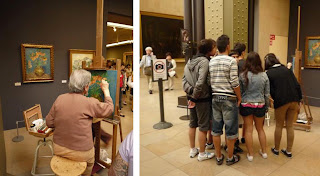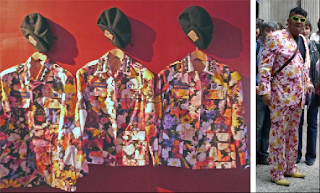We have decided to reduce the posting to once a day, just until we get back. Cheers, OTN.
Thursday, June 30, 2011
On guard
Posted by
jim and Mary
at
5:50 AM
![]()
![]()
Labels: art museum, performance
Wednesday, June 29, 2011
If you call it living
Posted by
jim and Mary
at
6:52 AM
![]()
![]()
Labels: lookalike, public sculpture
Tuesday, June 28, 2011
Spaced out
Posted by
jim and Mary
at
5:30 AM
![]()
![]()
Labels: architecture
Monday, June 27, 2011
Armless
Posted by
jim and Mary
at
6:00 AM
![]()
![]()
Labels: public sculpture
Saturday, June 25, 2011
Dogged
Posted by
jim and Mary
at
5:40 AM
![]()
![]()
Labels: architecture
Friday, June 24, 2011
Power play
Posted by
jim and Mary
at
11:53 AM
![]()
![]()
Labels: curators, installation
Heigh ho, heigh ho
- Changing the candle for the video installation One candle by Nam June Paik
- Ordering a new arrangement of fresh flowers in muted tones for a large floral arrangement work by Jeroen de Rijke and Willem de Rooij
- Keeping track of the location of the Odradek, an enigmatic object associated with a Jeff Wall light box work based on the Kafka story The Cares of a Family Man
- Showing a pearl to selected visitors as part of a performance piece Two shells by Massimo Bartolini
- Organising someone to lie down in Gregor Schneider’s installation N. Schmidt.
- Replenishing the customised pencils in Siah Armajani's Sacco & Vanzettil-Lesenraum
- Arranging a dancer to perform on Sturtevant’s version of Felix Gonzalez-Torres's work “Untitled” (Go-Go Dancing Platform)
- Replacing the lemon on the Joseph Beuys edition Capri Battery
Posted by
jim and Mary
at
6:54 AM
![]()
![]()
Labels: art museum, installation
Thursday, June 23, 2011
Good impression
Posted by
jim and Mary
at
11:54 AM
![]()
![]()
Labels: architecture, lookalike
Advice to collectors
Posted by
jim and Mary
at
6:58 AM
![]()
![]()
Labels: advice to collectors, sculpture
Wednesday, June 22, 2011
Uplifting
Posted by
jim and Mary
at
6:59 AM
![]()
![]()
Labels: dealer gallery, sculpture
Tuesday, June 21, 2011
One day in the director’s office
Posted by
jim and Mary
at
6:58 AM
![]()
![]()
Labels: exhibitions
Monday, June 20, 2011
Heists in the news
Typewriter heaven
Posted by
jim and Mary
at
6:54 AM
![]()
![]()
Labels: architecture
Saturday, June 18, 2011
Friday, June 17, 2011
Inside outside flow
Posted by
jim and Mary
at
6:57 AM
![]()
![]()
Labels: installation, sculpture
Thursday, June 16, 2011
Says who?
John Marin
Max Weber
Yasuo Kuniyoski
Stuart Davis
Ben Shahn
Charles Burchfield
George Grosz
Franklin Watkins
a tie between Lyonel Feininger and Jack Levine
Photo copier
Posted by
jim and Mary
at
6:55 AM
![]()
![]()
Labels: art museum, copy cat, photography
Wednesday, June 15, 2011
Crowded house
- Concentrate on works that are not covered by the audio guide. Most people pass by them quickly looking for the next audio symbol.
- Head straight to the end of the exhibition and work your way back to the beginning. Most people run out of energy for the last third of the show and the paintings are much easier to see.
- Learn to enjoy drawings and watercolours and prints. No one else is even vaguely interested.
- Take photos to remind yourself of what attracted you to the works you liked. There were ‘no photography’ signs everywhere but the guards had given up.
Posted by
jim and Mary
at
4:50 AM
![]()
![]()
Labels: advice to art museum visitors, art museum
Tuesday, June 14, 2011
In bad taste
Posted by
jim and Mary
at
5:00 AM
![]()
![]()
Labels: advertising
Monday, June 13, 2011
plus ça change, plus ce'est la même chose
Saturday, June 11, 2011
Saturday's chART
Friday, June 10, 2011
NZer SD does 3D at KW
Posted by
jim and Mary
at
6:24 AM
![]()
![]()
Labels: exhibitions
Thursday, June 09, 2011
MEmes
Yes, it feels a bit creepy to see your own stuff repurposed like this without your involvement and yes, based on what our Facebook content delivered we need to get out there and live more online if we want stellar Museums of Me, but you can certainly see the potential when just a few standard templates are populated with images from your life.
How to make a better impression? Start a Facebook page with nothing but images of your favourite art works (or even your own works) and The Museum of Me will reflect this identity right back at you and anyone else you link in for the ride.
Wednesday, June 08, 2011
Artless
Tuesday, June 07, 2011
Theme music
Posted by
jim and Mary
at
11:58 AM
![]()
![]()
Labels: style, venice biennale
If it’s broke, fix it
Posted by
jim and Mary
at
5:48 AM
![]()
![]()
Labels: Christchurch quake, venice
Monday, June 06, 2011
Advice for collectors
Posted by
jim and Mary
at
11:59 AM
![]()
![]()
Labels: advice to collectors, venice biennale
Tree house
Image: A shot too far for our OTN zoom lens on the other side of the Grand Canal of the olive tree on Filippo Gaggia's window ledge
Posted by
jim and Mary
at
6:05 AM
![]()
![]()
Labels: parekowhai, venice biennale
Saturday, June 04, 2011
Business as usual
Friday, June 03, 2011
Big ears at the Venice Biennale
For better or worse
Thursday, June 02, 2011
Art is where you find it
Posted by
jim and Mary
at
11:59 AM
![]()
![]()
Labels: venice biennale
It’s off to work we go
Images: Top Natural Habitat. Bottom left Luna's Artefact and right Tilda Swinton in Cornelia Parker's The Maybe
Wednesday, June 01, 2011
Colour me red
Posted by
jim and Mary
at
5:03 AM
![]()
![]()
Labels: parekowhai, venice biennale



























































